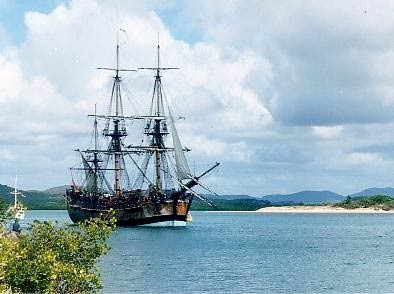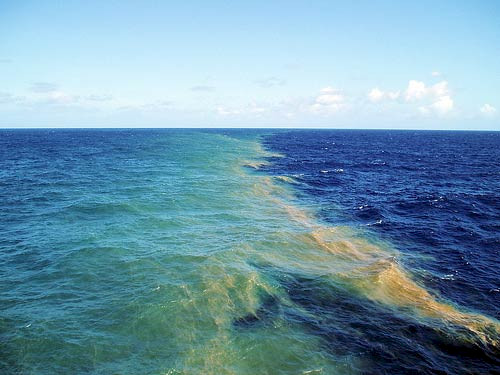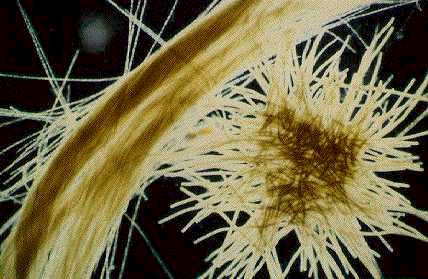The HMS Endeavour 'discovers' the Great Barrier Reef
Bill Dennison ·Another observation was the June 11, 1770 'discovery' that the Endeavour had been unknowingly threading through the Great Barrier Reef. This 'discovery' of what is now known as Endeavour Reef almost led to the demise of the ship and crew. Cook wrote ". . .the Ship Struck and stuck fast. Immediately upon this we took in all our Sails, hoisted out the Boats and Sounded round the Ship, and found that we had got upon the South-East Edge of a reef of coral rocks . . .". As usual, Banks was more dramatic and wrote "Our situation became now greatly alarming . . .", and "Now in my own opinion I intirely gave up the ship and packing up what I thought I might save prepard myself for the worst." Cook had the ship's boats carry the anchor out and attempted to heave the Endeavour off the reef to no avail. They jettisoned the cannons, ballast, casks and anything else they could get rid of. Fortunately, there was little wind, because they had struck at high tide and it was some 35 hours before the ship could be sailed off the reef.
The coral had put a large hole in the hull which the sailors stemmed by lowering a sail over the side of the ship and using it to 'fother' the leak, and coupled with frantic pumping by the crew, they kept the HMS Endeavour afloat long enough to sail into a river (now named the Endeavour River) and beach the ship in what is now Cooktown. They examined the hull and Cook discovered "A large peice of Coral rock was sticking in one Hole, and several peices of the Fothering, small stones, etc., had made its way in, and lodged between the Timbers, which had stopped the Water from forcing its way in in great Quantities." Banks wrote "The effects of the Coral rock upon her bottom is difficult to describe but more to beleive; it had cut through her plank and deep into one of her timbers, smoothing the gashes still before it so that the whole might easily be imagind to be cut with an axe." The coral had not only stopped the HMS Endeavour in its tracks, but the piece that had broken off had likely saved the ship. The unplanned stay to repair the hull allowed Banks and his team to collect and catalog numerous plants and animals as well as observe the natives.

Before setting off again, Cook and Banks climbed a high hill and Cook observed ". . . I had an extensive view of the Sea Coast; it afforded us a melancholy prospect of the difficulties we are to encounter, for in whatever direction we looked it was cover'd with Shoals as far as the Eye could see . . .". This was the first time that they appreciated the extensive nature of the Great Barrier Reef.
HMS Endeavour sailors coin the name 'Sea Sawdust' for Trichodesmium blooms
Another observation occurred on August 28, 1770 when the Endeavour was in Torres Strait and they encountered a large surface bloom of Trichodesmium, the pelagic cyanobacterium, which they initially mistook for a shoal. Cook wrote "The Sea in many places is her cover'd with a kind of a brown scum, such as Sailors generally call spawn; upon our first seeing it it alarm'd us, thinking we were among Shoals, but we found the same depth of Water were it was as in other places; neither Mr. Banks nor Dr. Solander could tell what it was, altho' they had of it to Examine."

Banks wrote of the same encounter "At dinner time we were alarmd afresh by the usual report of a shoal just ahead; it provd however to be no more than a bank of regular layer of a Brownish colour extending itself upon the sea, which indeed had very much the appearance of a shoal while at a distance. It was formd by innumerable small atoms each scarce ½ a line in lengh yet when lookd at in a microscope consisting of 30 or 40 tubes, each hollow and divided throughout the whole lengh into many cells by small partitions like the tubes of Confervas; to which of the three kingdoms of Nature they belong I am totally Ignorant, I only guess that they are of a vegetable nature because on burning them I could perceive no animal smell." Banks' little experiment of burning the sample and smelling the odor resulted in the correct conclusion. His microscopic examination accurately describes a bundle of Trichodesmium trichomes that form a tuft.

On the following day, Banks wrote "Vast quantities of the little substances mentioned yesterday floating upon the water in large lines a mile or more long and 50 or 100 yards wide, all swimming either immediately upon the surface of the water or not many inches under it. The seamen who are now convinc'd that it was not as they had thought the spawn of fish began to call it Sea Sawdust, a name certainly not ill adapted to its appearance." This name, 'Sea Sawdust', that the HMS Endeavour sailors came up with and related by Banks for Trichodesmium is still in use.
References:
Captain Cook's Journal During the First Voyage Round the World. Cook, James (1728-1779) Kindle edition
The Endeavour Journal of Sir Joseph Banks. Banks, Sir Joseph (1743-1820) Kindle edition
This is the second of three posts about the voyage of the Endeavour
The other two posts are:
1. Scientific discovery aboard the HMS Endeavour
3. HMB Endeavour sets sail
About the author
Bill Dennison

Dr. Bill Dennison is a Professor of Marine Science and Vice President for Science Application at the University of Maryland Center for Environmental Science.
Next Post > Scientific discovery aboard the HMS Endeavour
Comments
-
ian mcdonnell 11 years ago
Hi Prof
Why the scare quotes around discovery. Lt Cook did discover the GBR as he was the first to chart and describe this marine phenomenon and this allowed the rest of the world to know it existed. Discovery, surely?